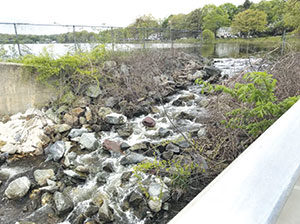
An estimated 589,000 river herring migrated upstream to spawn at Mystic Lakes in 2018 according to numbers just released by the Massachusetts Division of Marine Fisheries (DMF). If you stacked the fish end-to-end this would be over one hundred miles of river herring—enough to get you from Boston to Provincetown-in a river that is only 7 miles long.
“Every spring you see the river come to life when the herring begin their migration—the banks become filled with black-crowned night herrings, and overhead you see gulls, eagles and hawks eagerly awaiting the return of the herring,” said Patrick Herron, Executive Director.
It is not just birds that this migration attracts. The Mystic River Watershed Association runs both in-person and a video monitoring programs to help the Division of Marine Fisheries (DMF) document this migration, plus hosts dozens of schools and youth groups reaching 400 youth at the Mystic Lakes Dam to introduce them to their local wildlife migration.
In the 2018 program, 85 volunteers logged more than 400 observations at the Mystic Lakes Dam. The data are plugged into a sophisticated model developed by the DMF that yields the population estimate of 589,924+/- 74,087 herring for 2018.
The number of herring migrating continues to be strong as additional spawning ground is opened up through fish ladders—first at the Mystic Lakes Dam (2012) and most recently at Winchester Falls (2018). As a result, Alewife and Blueback herring can travel from the Atlantic Ocean up the Mystic River, the Aberjona River, and Horn Pond Brook to spawn in Horn Pond in Woburn for the first time in more than a hundred years. A handful of volunteers at this site helped monitor herring swimming up the spillway—DMF used this data to determine that an estimated 25,000 herring made it to Horn Pond.
“This is a real ecological success story—with herring numbers rebounding–thanks in a large part to citizen awareness and action,” said Andy Hrycyna. “Herring are a keystone species—supporting a healthy local ecosystem and also serving as an important part of the food web in the Atlantic Ocean. By helping our local herring reach Horn Pond in Woburn we are having far-reaching impacts.”
Though the migration is over, you can still see videos of these fish traveling through the Mystic Lakes Dam using our “fish cam” at MysticHerring.org. The site also includes facts and information about this migration and the importance to our watershed.
About River Herring: River herring collectively refer to two species of herring, Blueback (Alosa aestivilis) and Alewife (Alosa pseudoharengus). These two species are referred to as “anadromous” fish as they live the majority of their life in salt water but lay eggs (spawn) in fresh water. The billions of river herring eggs that are produced in Upper Mystic Lake will develop into juvenile herring within just a few days. These juveniles will stay in the fresh water for up to 4 months before swimming downstream to live in estuarine waters. The river herring that survive will reach an age to reproduce after 3-4 years and usually return to the same waters where they were born. River herring are an important component of ocean fisheries, and they need access to freshwater systems to survive. Over the past several decades, populations of river herring have dramatically declined due to a variety of issues, including habitat loss.
About the Mystic River Watershed Association: The Mystic River Watershed Association (MyRWA) works to improve the lives of the more than half million residents of Mystic River communities through its efforts to protect and restore water quality, natural habitat and open space throughout the 76 square mile watershed. For more information see www.MysticRiver.org.















Reader Comments